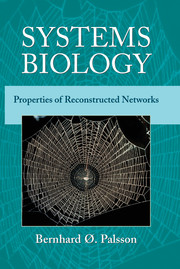Book contents
- Frontmatter
- Contents
- Preface
- 1 Introduction
- 2 Basic Concepts in Systems Biology
- PART I RECONSTRUCTION OF BIOCHEMICAL NETWORKS
- PART II MATHEMATICAL REPRESENTATION OF RECONSTRUCTED NETWORKS
- PART III CAPABILITIES OF RECONSTRUCTED NETWORKS
- APPENDIX A Nomenclature and Abbreviations
- APPENDIX B E. coli Core Metabolic Network
- Bibliography
- Index
PART III - CAPABILITIES OF RECONSTRUCTED NETWORKS
Published online by Cambridge University Press: 05 September 2012
- Frontmatter
- Contents
- Preface
- 1 Introduction
- 2 Basic Concepts in Systems Biology
- PART I RECONSTRUCTION OF BIOCHEMICAL NETWORKS
- PART II MATHEMATICAL REPRESENTATION OF RECONSTRUCTED NETWORKS
- PART III CAPABILITIES OF RECONSTRUCTED NETWORKS
- APPENDIX A Nomenclature and Abbreviations
- APPENDIX B E. coli Core Metabolic Network
- Bibliography
- Index
Summary
The functional states of reconstructed networks are directly related to cellular phenotypes. With reconstructed networks represented in the form of S, we can use mathematics to compute their candidate functional states of reconstructed networks. If one adopts the informatics point of view of S and its annotated information as biochemically, genetically, and genomically (BIGG) structured database, then these in silico methods are viewed as query tools. Whether viewed from an informatic or mathematical standpoint, the result of applying in silico analysis methods is the study of network properties, sometimes called emergent properties. These properties represent functionalities of the whole network and are hard to decipher from a list of its individual components. In some sense, these properties are a reflection of the hierarchical nature of living systems. A variety of methods have been developed to examine the properties of genome-scale networks. The third part of this text summarizes the in silico methods that have been developed and deployed to date. The development and application of such methods is the focus of a growing number of researchers worldwide, and we can thus anticipate that there will be much progress in this field over the coming years.
- Type
- Chapter
- Information
- Systems BiologyProperties of Reconstructed Networks, pp. 177 - 178Publisher: Cambridge University PressPrint publication year: 2006



